|
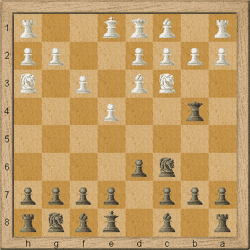 |
Origin
It seems that everybody agrees about the Indian origin of this board game, derived from Chaturanga, a board game already practised in India between the 5th and 6th centuries. Chess migrated to Persia, where quickly reached a great popularity. Later, between 7th and 9th centuries, Islam conquests introduced it in the southern part of Europe; the crusades and Vikings contributed to extend chess to the rest of Europe.
The current chess rules were consolidated between the 16th and 17th centuries.
Game rules
Chess is the widely played board game all over the world. There are many regional and national federations, and one international federation (FIDE) that publishes the official "Chess rules". So, we opt for copying the first 5 articles from those rules.
The nature and objectives of the game of chess (article 1)
1.1. The game of chess is played between two opponents who move pieces alternately on a square board called a "chessboard". The player with the white pieces commences the game. A player is said to "have the move", when the opponent´s move has been completed.
1.2. The objective of each player is to place the opponent´s king under attack in such a way that the opponent has no legal move which would avoid the capture of the king on the following move. The player who achieves this is said to have checkmated the opponent and to have won the game. The opponent who has been checkmated has lost the game.
1.3. If the position is such that neither player can possibly checkmate, the game is drawn.
The initial position of the pieces on the chessboard (article 2)
2.1. The chessboard is composed of an 8x8 grid of 64 equal squares alternately light (the "white" squares) and dark (the "black" squares).
The chessboard is placed between the players in such a way that the near corner square to the right of the player is white.
2.2. At the beginning of the game one player has 16 light pieces (the "white" pieces); the other has 16 dark pieces (the "black" pieces).
These pieces are as follows:
- A white king, usually indicated by the symbol:

- A white queen, usually indicated by the symbol:

- Two white rooks, usually indicated by the symbol:

- Two white bishops, usually indicated by the symbol:

- Two white knights, usually indicated by the symbol:

- Eight white pawns, usually indicated by the symbol:

- A black king, usually indicated by the symbol:

- A black queen, usually indicated by the symbol:

- Two black rooks, usually indicated by the symbol:

- Two black bishops, usually indicated by the symbol:

- Two black knights, usually indicated by the symbol:

- Eight black pawns, usually indicated by the symbol:

2.3. The initial position of the pieces on the chessboard is as follows:
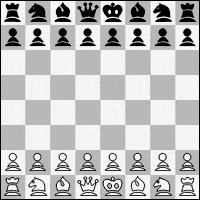
2.4. The eight vertical columns of squares are called "files". The eight horizontal rows of squares are called "ranks". A straight line of squares of the same colour, touching corner to corner, is called a "diagonal".
The moves of the pieces (article 3)
3.1. No piece can be moved to a square occupied by a piece of the same colour. If a piece moves to a square occupied by an opponent´s piece the latter is captured and removed from the chessboard as part of the same move. A piece is said to attack a square if the piece could make a capture on that square according to Articles 3.2 to 3.5.
3.2.
a) The queen moves to any square along the file, the rank or a diagonal on which it stands.
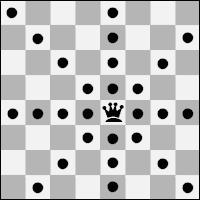
b) The rook moves to any square along the file or the rank on which it stands.
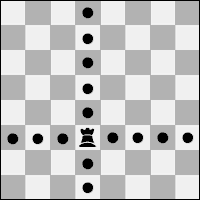
c) The bishop moves to any square along a diagonal on which it stands.
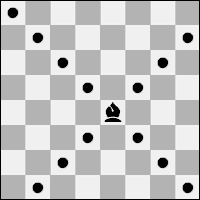
When making these moves the queen, rook or bishop cannot move over any intervening pieces.
3.3. The knight moves to one of the squares nearest to that on which it stands but not on the same rank, file or diagonal. It does not pass directly over any intervening square.
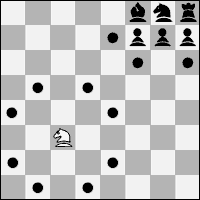
3.4.
a) The pawn moves forward to the unoccupied square immediately in front of it on the same file, or...
b) on its first move the pawn may advance two squares along the same file provided both squares are unoccupied, or...
c) the pawn moves to a square occupied by an opponent´s piece which is diagonally in front of it on an adjacent file, capturing that piece.
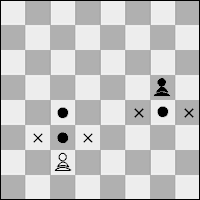
d) A pawn attacking a square crossed by an opponent´s pawn which has advanced two squares in one move from its original square may capture this opponent´s pawn as though the latter had been moved only one square. This capture can be made only on the move following this advance and is called an "en passant" capture.
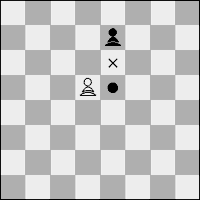
e) When a pawn reaches the rank furthest from its starting position it must be exchanged as part of the same move for a queen, rook, bishop or knight of the same colour. The player´s choice is not restricted to pieces that have been captured previously. This exchange of a pawn for another piece is called "promotion" and the effect of the new piece is immediate.
3.5.
a) The king can move in two different ways, by:
(i) moving to any adjoining square that is not attacked by one or more of the opponent´s pieces,
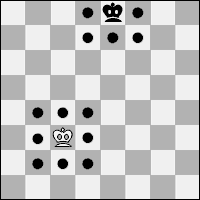
Or...
(ii) "castling". This is a move of the king and either rook of the same colour on the same rank, counting as a single move of the king and executed as follows: the king is transferred from its original square two squares towards the rook, then that rook is transferred over the king to the square the king has just crossed.
Before kingside castling.
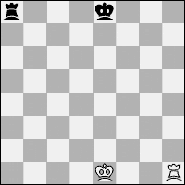
After kingside castling.
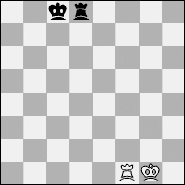
Before queenside castling.
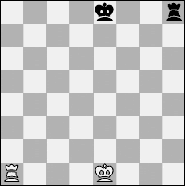
After queenside castling.
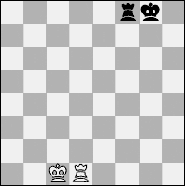
(1) Castling is illegal:
[a] if the king has already been moved, or...
[b] with a rook that has already been moved.
(2) Castling is prevented for the time being:
[a] if the square on which the king stands, or the square which it must cross, or the square which it is to occupy, is attacked by one or more of the opponent´s pieces.
[b] if there is any piece between the king and the rook with which castling is to be effected.
b) The king is said to be "in check", if it is under attack by one or more of the opponent´s pieces, even if such pieces cannot themselves move. Declaring a check is not obligatory.
3.6. A player must not make a move which places or leaves his own king in check.
The act of moving the pieces (article 4)
4.1. Each move must be made with one hand only.
4.2. Provided that he first expresses his intention (e.g. by saying "j´adoube"), the player having the move may adjust one or more pieces on their squares.
4.3. Except as provided in Article 4.2, if the player having the move deliberately touches on the chessboard.
a) one or more pieces of the same colour, he must move or capture the first piece touched that can be moved or captured, or...
b) one piece of each colour, he must capture the opponent´s piece with his piece or, if this is illegal, move or capture the first piece touched which can be moved or captured. If it is unclear the player´s own piece shall be considered to have been touched before his opponent´s.
4.4.
a) If a player deliberately touches his king and rook he must castle on that side if it is legal.
b) If a player deliberately touches a rook and then his king he is not allowed to castle on that side on that move and the situation shall be governed by Article 4.3.
c) If a player, intending to castle touches the king or king and rook at the same time, but castling on that side is illegal, the player must choose either to castle on the other side, provided that castling on that side is legal, or to move his king. If the king has no legal move, the player is free to make any legal move.
4.5. If none of the pieces touched can be moved or captured, the player may make any legal move.
4.6. If the opponent violates Article 4.3 or 4.4 the player cannot claim this after he himself deliberately touches a piece.
4.7. When, as a legal move or part of a legal move, a piece has been released on a square, it cannot then be moved to another square. The move is considered to be made when all the relevant requirements of Article 3 have been fulfilled.
The completed game (article 5)
5.1.
a) The game is won by the player who has checkmated his opponent´s king with a legal move. This immediately ends the game.
b) The game is won by the player whose opponent declares he resigns. This immediately ends the game.
5.2. The game is drawn when the player to move has no legal move and his king is not in check. The game is said to end in "stalemate". This immediately ends the game.
5.3. The game is drawn upon agreement between the two players during the game. This immediately ends the game.
5.4. The game is drawn if the same position is repeated three times during the game. This immediately ends the game.
5.5. The game may be drawn if the last 50 consecutive moves have been made by each player without the movement of any pawn and without the capture of any piece.
The last two articles are applicated if any of the players want it; in this version the game finishes automaticly
Play now
Play online with some other players
Related links
Copyright © 2001-2026 Ludoteka.com Jokosare S.L. All rights reserved - Disclaimer - Cookies - Contact
